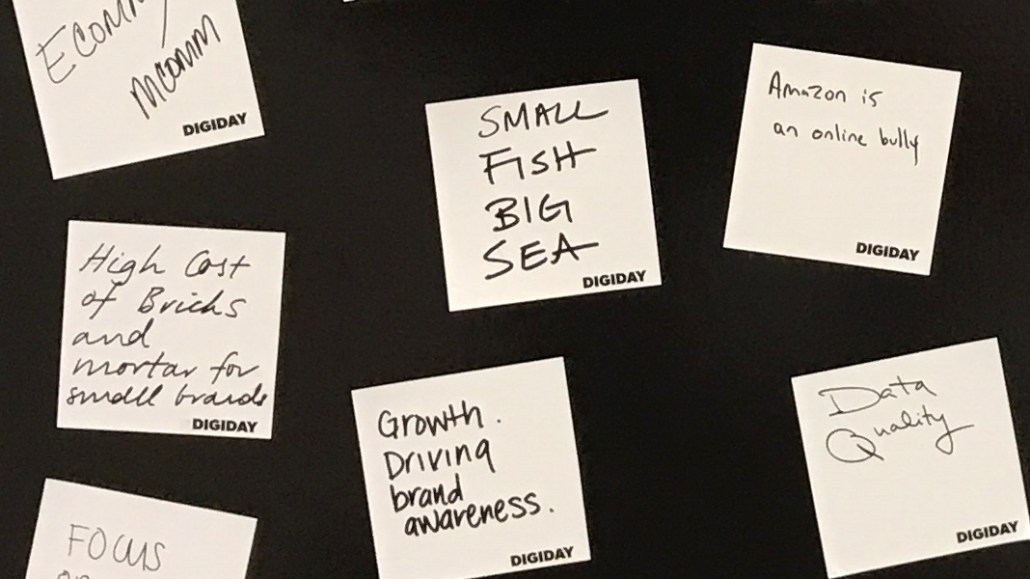
This week, executives from retailers large and small — including Target, Tiffany & Co., Macy’s and M.Gemi — gathered in Napa, California, for the Digiday Retail Summit, focused on the changing state of retail.
We held group meetings where retailers discussed some of the biggest challenges they’re facing today, including remaining competitive as the industry explores new sales channels and embraces data and technology. The following are highlights from Day 1’s session on the store of the future. Attendees agreed to openly comment on the record, in exchange for anonymity.
Defining the store of the future
“We talk about the store of the future in present tense: How are we effectively interacting with customers in multiple ways? It’s not just about getting them to come into our store or go to our e-commerce page; we’re looking at whether sales have continued to grow day after day and remaining one step ahead of the competition.”
“Is the purpose of the store of the future to sell? To brand? To drive online sales? We’re still figuring it out.”
“The store of the future means something different to different retailers. What are you aiming for? Providing an omnichannel experience? Successfully tracking your consumer from online to your store? It’s more a mindset.”
“[Retailers] usually associate the store of the future with AI, but the focus should be more on basics: scalable dressing room sizes, a smaller footprint, more curation. Look at Bonobos’ Guideshops. You walk in, you get great service, you don’t wind up with shit thrown all over the place — it’s an easy experience for the customer.”
“When we think about the store of the future, we don’t want it to be touch screens on the wall. We want it to be aggressive, yet feel like it’s not there.”
Ad position: web_incontent_pos1
“Between mobile, desktop and the store, the experience should be frictionless. What you experience when you’re on the phone and when you go to the store should play into the same story.”
“The store of the future may come down to finding the right balance: How do you combine your e-commerce solutions, which provide ease for your customer, with brick-and-mortar — because people still do like to go shopping.”
Roadblocks for retailers
“Technology is moving so quickly, and we still plan three to five years out. When the time comes to implement our ideas and ‘new’ technologies, they’re irrelevant.”
“Our customer is shopping online and in-store. At my workplace, these two areas are in silos. As we try to bridge those silos, budgets get complicated — a lot of things get complicated.”
“At some point, there is going to be a mix of consumers: Some are going to be digital-only, some are going to be omnichannel, some are going to be in-store-only. How do you speak to all of them in a personalized way, to make them want to purchase and come back?”
Ad position: web_incontent_pos2
“Retailers need to be doing something differently than they see now and what they did yesterday. There’s a lot of importance in looking ahead five years and brainstorming possibilities, so they’re not just in the same place. It’s not easy, but it pays to be disruptive.”
More in Marketing

In the marketing world, anime is following in the footsteps of gaming
As marketers look to take advantage of anime’s entry into the zeitgeist, they might be wise to observe the parallels between the evolution of anime as a marketing channel and the ways brands have learned to better leverage gaming in recent years.

With the introduction of video ads and e-commerce, Roblox looks to attain platform status
Roblox is expanding into more areas than just ads in 2024. Much like platforms such as Amazon and Facebook have transcended their origins to evolve from their origins as online marketplaces and social media channels, Roblox is in the midst of a transformation into a platform for all elements of users’ virtual lives.

PepsiCo wants to remain a ‘driver of culture’ as it turns to influencers and activations amid rebrand
The soda-maker says it can translate cultural relevance into sales volume.
Ad position: web_bfu


